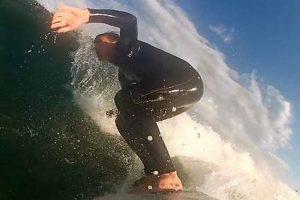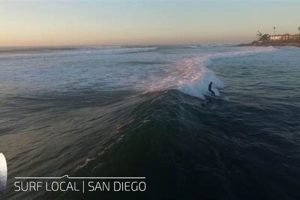A system for gathering, processing, and distributing information about ocean conditions relevant to surfing forms the basis of informed decisions for wave riders. This system generally encompasses data acquisition from various sources, analytical processing, and the delivery of synthesized findings. For example, such a system might collect wave buoy data, satellite imagery, and wind measurements, combine these inputs using hydrodynamic models, and then disseminate the resulting forecasts through websites and mobile applications.
The value of such a formalized process lies in its ability to provide timely and accurate insights. This increases surfer safety by allowing for informed assessments of potential hazards. Furthermore, it facilitates optimal surf session planning, maximizing opportunities to capitalize on favorable wave conditions. Historically, surfers relied on anecdotal evidence and rudimentary observations. Modern systems significantly enhance the scope and reliability of available information.
Subsequent discussion will address the specific components, data sources, and technological advancements that characterize such processes. Furthermore, the application of these technologies in different surfing regions will be examined, alongside an evaluation of the accuracy and reliability of current forecasting methodologies.
Optimizing Surfing Through Effective Information Systems
The effective utilization of surf condition information is paramount for both recreational and professional surfing endeavors. Understanding how a comprehensive system functions allows surfers to make informed decisions regarding safety and wave selection.
Tip 1: Analyze Multiple Sources. Relying solely on a single source of information can be misleading. Cross-reference data from wave buoys, wind forecasts, and tidal charts for a more comprehensive understanding of the surf conditions.
Tip 2: Understand Wave Buoy Data. Learn to interpret wave height, period, and direction data from wave buoys. This provides a quantitative assessment of the wave energy reaching a particular location.
Tip 3: Monitor Wind Conditions. Offshore winds generally produce cleaner, more organized waves. However, excessive offshore winds can flatten wave faces. Consider the wind strength and direction in relation to the surf break’s orientation.
Tip 4: Assess Tidal Influences. Tides significantly impact wave quality, particularly at reef breaks and river mouths. Research the optimal tidal window for the specific surf spot being considered.
Tip 5: Account for Swell Direction. Different surf breaks are more receptive to swells from particular directions. Identify the swell windows for various locations to maximize wave-riding opportunities.
Tip 6: Consider Local Knowledge. Consult local surfers and surf shop employees for insights into micro-conditions and hidden hazards at specific surf spots.
Tip 7: Continuously Evaluate Forecast Accuracy. Compare predicted conditions with actual observations to refine understanding of forecast reliability at particular locations.
Effective analysis of readily available data allows for better decision-making. These tips are designed to help use the available data to your advantage, making surfing experiences safer and more rewarding.
The following section will delve into case studies that demonstrate the practical application of these principles in real-world surfing scenarios.
1. Data acquisition methods
Data acquisition methods are fundamental to the integrity and utility of any surf report pipeline. The quality and diversity of collected data directly influence the accuracy and reliability of subsequent wave forecasts. A robust system relies on multiple, complementary data streams to provide a comprehensive representation of ocean conditions.
- Wave Buoy Networks
Wave buoy networks, such as the National Data Buoy Center (NDBC), provide real-time measurements of wave height, period, and direction. Strategically positioned buoys transmit data that serves as a primary input for wave models. The spatial density of buoy deployments impacts the resolution and accuracy of forecasts, particularly in regions with complex bathymetry.
- Satellite Altimetry
Satellite altimeters measure sea surface height, providing indirect information about wave characteristics and swell propagation. Although less precise than buoy measurements, satellite data offers global coverage, filling gaps in buoy networks. Combining satellite and buoy data enhances the accuracy of large-scale wave models and improves long-range forecasts.
- Numerical Weather Prediction (NWP) Models
NWP models simulate atmospheric conditions, including wind speed and direction. Wind data is crucial for predicting wave generation and propagation. High-resolution NWP models capture localized wind patterns that influence wave development near coastlines. Accurate wind forecasts are essential for predicting storm swells and wind chop.
- Coastal Radar Systems
Coastal radar systems, such as High-Frequency (HF) radar, measure surface currents and wave characteristics in nearshore waters. HF radar provides high-resolution data on wave direction and speed, complementing buoy and satellite measurements. This data is particularly valuable for monitoring wave conditions in surf zones and identifying rip currents.
The synergistic integration of data from wave buoys, satellite altimetry, numerical weather prediction models, and coastal radar systems is crucial for a comprehensive and reliable surf report pipeline. Enhancements in data acquisition technologies and processing algorithms continuously improve the accuracy and utility of surf forecasts, enabling surfers to make informed decisions and maximize their experience.
2. Modeling and processing
Modeling and processing form the core of a functioning surf report pipeline. Without these steps, raw data from buoys, satellites, and weather models remains a collection of isolated measurements. The transformation of these inputs into a coherent, actionable forecast is achieved through sophisticated mathematical models and computational techniques. These models simulate wave generation, propagation, and interaction with coastal bathymetry.
The accuracy of a surf report is directly contingent on the quality of the models employed. For instance, spectral wave models, like WAVEWATCH III, simulate the evolution of wave energy across a spectrum of frequencies and directions. These models consider factors such as wind speed, fetch (the distance over which wind blows), and water depth. The computational intensity of these simulations necessitates high-performance computing resources. Imperfect models introduce errors that propagate through the forecast, potentially leading to inaccurate predictions of wave height, period, and direction. Consider a scenario where a model underestimates wind fetch; the resulting forecast would likely underpredict the size of the arriving swell. Accurate modeling is therefore indispensable.
Data assimilation techniques, such as Kalman filtering, are applied to refine model outputs by incorporating real-time observations. This process reduces forecast uncertainty and enhances accuracy. Effective data assimilation requires careful weighting of different data sources based on their reliability and relevance. Sophisticated modeling, accurate processing, and data assimilation are the keys to transforming disparate data into reliable wave forecasts, offering critical insights for safe and rewarding surfing experiences. As a result, improvements in these areas directly enhance the overall value and utility of a surf report pipeline.
3. Dissemination channels
The effectiveness of a surf report pipeline is ultimately determined by its ability to deliver timely and accurate information to end-users. Dissemination channels serve as the bridge between processed data and the surfers who rely on it for decision-making. The selection and implementation of appropriate dissemination channels are critical for maximizing the utility of the entire system.
- Websites and Mobile Applications
Websites and mobile applications are common platforms for delivering surf reports. These platforms can present information in a user-friendly format, incorporating visual aids such as maps, graphs, and surf cameras. Real-time updates and customizable alerts enhance user experience. However, reliance on internet connectivity can be a limitation in remote areas.
- API (Application Programming Interface) Integration
APIs allow developers to integrate surf report data into their own applications or websites. This fosters innovation and expands the reach of the information. For example, a hotel chain near a surf break might use an API to display surf conditions on its website, attracting surfing clientele. However, API access often requires subscription fees or licensing agreements.
- Social Media Platforms
Social media platforms such as Twitter and Instagram provide a rapid means of disseminating brief surf reports and alerts. Short-form content can quickly reach a large audience. However, the limited character count and potential for misinformation are disadvantages. Furthermore, social media algorithms may prioritize certain content, limiting the reach of surf reports to specific user groups.
- Traditional Media Outlets
Traditional media outlets, such as newspapers and television news programs, can disseminate surf reports to a broader audience. While not as timely as digital channels, traditional media provides credibility and reach to segments of the population less likely to use online platforms. However, the level of detail and frequency of updates are typically limited.
The optimal choice of dissemination channels depends on the target audience, the type of information being conveyed, and the available resources. Combining multiple channels can maximize the impact of the surf report pipeline. Continuous evaluation of dissemination channel effectiveness is essential for ensuring that surf reports reach the intended users in a timely and accessible manner.
4. Accuracy verification
Accuracy verification constitutes a critical component of any effective surf report pipeline. The value of a surf forecast diminishes significantly if its predictions deviate substantially from actual conditions. Consequently, a robust methodology for assessing and improving forecast accuracy is essential. Without such verification, the entire pipeline becomes susceptible to systematic errors and biases, undermining user confidence and potentially leading to unsafe surfing decisions.
Accuracy verification involves comparing predicted wave characteristics (height, period, direction) with observed data. Observed data can originate from several sources, including wave buoys, coastal radar, and visual observations from experienced surfers. Statistical metrics, such as root mean squared error (RMSE) and bias, quantify the discrepancies between forecasts and observations. For instance, if a surf report consistently underestimates wave height by 30%, this bias must be identified and addressed through model recalibration or data assimilation techniques. Real-world examples reveal that unverified surf reports often exhibit significant inaccuracies, particularly during rapidly changing weather patterns or in regions with complex coastal geography. This reinforces the practical need for rigorous validation procedures.
Ultimately, continuous accuracy verification drives improvements in the surf report pipeline. By identifying and correcting systematic errors, forecast models become more reliable and provide surfers with increasingly accurate information. This leads to enhanced safety, optimized surf session planning, and a greater appreciation for the value of scientifically informed surf forecasting. The challenges lie in obtaining sufficiently comprehensive and reliable observational data and developing statistical methods that effectively capture the complex dynamics of wave behavior. Addressing these challenges is paramount for ensuring the continued relevance and utility of surf report pipelines.
5. User accessibility
User accessibility is an indispensable component of a functional surf report pipeline. The effectiveness of any data collection, modeling, or dissemination effort is nullified if the resulting information remains inaccessible or incomprehensible to the intended audience. A pipeline generating highly accurate forecasts delivered in a technical format beyond the grasp of the average surfer serves little practical purpose. The connection between the pipeline and its users is direct: improved accessibility fosters wider adoption, leading to more informed decision-making and enhanced safety in the water. For example, a website requiring advanced knowledge of meteorological terminology would be less accessible than an app displaying simple icons and color-coded wave height indicators.
Consider the practical implications of varying access levels. A professional surfer may require detailed data, such as spectral wave period or swell direction in degrees, readily available through a subscription-based API. In contrast, a novice surfer might benefit more from a simplified interface displaying a “surfability” rating and basic safety advisories. The dissemination channel must be tailored to the specific user profile. Furthermore, accessibility encompasses not only the format of the information but also the platform on which it is delivered. Mobile-friendly interfaces, offline capabilities, and multilingual support expand access to a wider range of users. Ignoring these factors results in a fragmented system where only a select few can fully leverage the available information.
In summary, user accessibility directly influences the success of a surf report pipeline. Overcoming barriers to accesswhether they be technical, linguistic, or economicis essential for maximizing the pipeline’s impact on surfer safety and enjoyment. Future developments should prioritize user-centered design principles, ensuring that surf reports are not only accurate but also readily available and easily understandable to all members of the surfing community. The challenge lies in balancing the need for detailed scientific information with the imperative of clear and concise communication.
Frequently Asked Questions
This section addresses common inquiries concerning the gathering, processing, and dissemination of surf condition information. The goal is to clarify fundamental concepts and address misconceptions surrounding surf forecasting methodologies.
Question 1: What are the primary data sources used in a surf report pipeline?
The system primarily relies on wave buoys providing real-time wave height and period data, satellite altimetry measuring sea surface height, and numerical weather prediction models for wind forecasts. These sources collectively contribute to a comprehensive understanding of ocean conditions.
Question 2: How does data from different sources get integrated?
Raw data undergoes processing through wave propagation models, which simulate wave generation and movement across the ocean. Data assimilation techniques, such as Kalman filtering, combine real-time observations with model outputs to refine forecast accuracy.
Question 3: Why do surf reports sometimes differ from actual conditions?
Forecast inaccuracies stem from various factors, including limitations in model accuracy, incomplete data coverage, and rapidly changing weather patterns. Real-time conditions in nearshore areas may diverge significantly from offshore predictions.
Question 4: How can the accuracy of a surf report be evaluated?
Accuracy is assessed by comparing predicted wave characteristics (height, period, direction) with observed data from wave buoys, coastal radar, and visual observations. Statistical metrics quantify the discrepancies between forecasts and actual conditions.
Question 5: What factors influence the reliability of a surf report for a specific location?
The reliability depends on the proximity of data sources, the complexity of coastal bathymetry, and the skill of the forecasting models. Locations near wave buoys and with relatively simple coastal features tend to have more reliable forecasts.
Question 6: Are subscription-based surf reports more accurate than free reports?
Subscription-based services may offer access to higher-resolution data, more sophisticated models, and expert analysis. However, accuracy ultimately depends on the quality of the underlying data and modeling techniques, regardless of cost.
The value of a surf report pipeline is determined by its ability to provide timely and accurate information. Understanding its limitations and complexities increases the user’s ability to use these tools properly.
In the next section, we will explore emerging trends in surf forecasting technology and their potential impact on the surfing experience.
Conclusion
The preceding discussion has explored the multifaceted nature of the surf report pipeline, encompassing data acquisition, modeling, dissemination, accuracy verification, and user accessibility. Each component plays a critical role in translating raw oceanographic data into actionable intelligence for surfers. Effective implementation of each stage is paramount for generating reliable and informative forecasts.
Continued refinement of the surf report pipeline remains crucial for enhancing surfer safety and optimizing wave-riding experiences. Advancements in data acquisition technologies, sophisticated modeling techniques, and user-friendly dissemination platforms will undoubtedly shape the future of surf forecasting. Prioritizing accuracy, accessibility, and continuous improvement will ensure the continued relevance and value of the surf report pipeline for the global surfing community.







